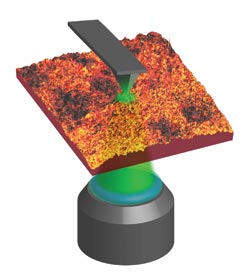Plastic solar cells are lightweight, flexible and, most importantly, cheap to make. But so far, these devices lack one thing: efficiency.
Now researchers at the University of Washington in Seattle believe that they may have the key to unlocking the true potential of plastic solar cells. By taking a closer look at their inner workings at the microscopic and even nanoscopic level, the group believes it could help bring the technology a step closer to fulfilling its promise as a low-cost source of solar energy.
The fabrication of plastic solar cells usually involves blending two materials together in a thin film. They are then annealed, or baked, to improve their performance. In the process, bubbles and channels form, and it is these nano-structures that determine how well the cell converts light into electricity and how much of the electricity actually gets to the wires leading out of the cell.
According to lead researcher David Ginger, the trick to understanding what is happening within polymer solar cells is to think of them not as giant uniform blocks of material with average properties, but rather as networks of many billions of nanoscale solar cells wired in parallel. “Not all of the smaller cells are working as efficiently as they could because they have different sizes, shapes or compositions,” Ginger explained.

University of Washington doctoral chemistry student Obadiah Reid aligns the laser in a dual optical/atomic force microscope prior to performing photoconductive atomic force microscopy on nanostructured polymer solar cells.
In the study, which was published in the July 9 online edition of Nano Letters, Ginger, postdoctoral fellow Liam Pingree and doctoral student Obadiah Reid used an atomic force microscope to examine a plastic solar cell comprising a blend of polythiophene and fullerene. As the microscope traces back and forth across the cell, it records the channels and bubbles that were created as the material was formed.
What the Washington team discovered came as a surprise. The photocurrents coming out of the polymer/fullerene solar cell were not spatially uniform. In fact, they exhibited heterogeneities on the order of 10 to 100 nm. Ginger realized that if the solar cells could be processed such that all regions of the cell operated as well as the best regions, the overall performance of the cell could be improved.
“We realized that we ought to include this nanoscale heterogeneity into the theoretical models of device operation if we want to understand them better,” he noted.
But getting the cell constitution right is no trivial task, and many experts in the field already believe that they know what is needed to achieve maximum efficiency. Two important targets include better harvesting of red and near-infrared light with lower-bandgap polymers as well as better control of the material energy levels to maximize the cell voltage.

This is a 3-D schematic of the experiment performed by the University of Washington group.
The problem is that, while materials that meet these requirements exist, putting them together does not always render a solar cell as efficient as expected. “You could get the perfect bandgap and energy level offsets in your material, but if you can’t get it to form the right-size bubbles and channels on the nanoscale, then it won’t work very well,” Ginger commented.
Despite the challenges, the team is hopeful that, within the next few years, its technique will not only help others in the field gain a better understanding of polymer solar cells but also will be valuable in related disciplines. For example, nanoscale photocurrent imaging could be useful for laboratory optimization of new materials, for initial scale-up of production and, someday, for quality control during mass production.
In the meantime, the Washington group hopes to improve its imaging technique – making it faster, more user-friendly and less sensitive to surface effects. And along the way it also hopes to image new material combinations to optimize efficiency.